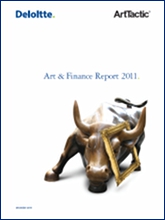Why do people collect art? For many reasons, obviously, but some weigh heavier than others.
ArtTactic and Deloitte Luxembourg recently conducted a survey of collectors and art advisors called Art & Finance Report 2011 — its first — and it produced some interesting results.
 For example, while the exact same percentage of advisors and collectors said that “Investment returns” were important or very important — 48.8 percent — art advisors overestimated by a mile the “social value” and art’s function as an “inflation hedge,” and they underestimated the “emotional value” and the “tax” and “portability” values of art. Are art collectors planning to flee something? 23.1% said portability was important or very important in buying art.
For example, while the exact same percentage of advisors and collectors said that “Investment returns” were important or very important — 48.8 percent — art advisors overestimated by a mile the “social value” and art’s function as an “inflation hedge,” and they underestimated the “emotional value” and the “tax” and “portability” values of art. Are art collectors planning to flee something? 23.1% said portability was important or very important in buying art.
Here’s the whole table on the question, “which of the following are the most important motivations in buying art?” (The percentages record those who said the motivation was important or very important):
Motivation % Art advisors % Collectors
Emotional Value 79.4 97.5
Social Value 73.7 22.5
Investment Returns 48.8 48.8
Inflation Hedge 27.5 35.0
Portfolio Diversification 41.8 29.3
Rarity 58.7 64.1
Luxury Good 56.3 40.0
Safe Haven 25.2 20.0
Tax 12.4 20.5
Portability 13.3 23.1
Despite those misreadings/misconceptions — or perhaps collectors weren’t being totally honest in a few cases — art advisors said elsewhere in the survey that almost half of their clients were driven by the potential for a return on their investment, with smaller but still large percentages recognizing other wealth management aspects of art.
As the report also notes, the growth of the art market over the last several years also means that “we now can start talking about the early stages of an Art and Finance industry.” Clearly they are in favor of this development, which appeals to the world’s high net worth individuals.
For museums and other collectors whose net worth is not all that high, this could be worrisome. The more people treat art as an investment, the more trading there will be, and as these art-finance services are sold to more people, prices for art, overall, are likely to rise. Museums then become even more dependent on gifts of art from collectors.
However, we’ve seen some of this before, with the rise of art investment firms that eventually closed. Whether this time is different remains to be seen.
The entire study is here.
